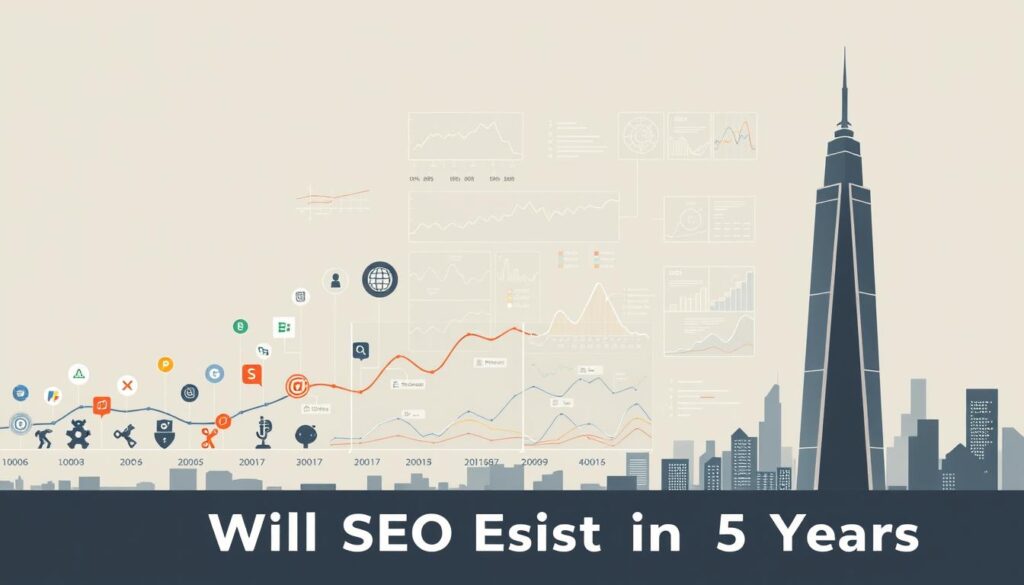For over two decades, businesses have debated whether search engine optimization will remain relevant. While some claim “SEO is dead,” industry leaders like Connor Gillivan argue it’s simply evolving. Historical trends show search engine strategies have adapted through algorithm updates, mobile dominance, and shifting user behaviors—and they’ll keep transforming.
Today’s landscape blends classic tactics with emerging tools like AI. Artificial intelligence now aids keyword research and content creation, but human creativity remains irreplaceable. As Gillivan notes, “The core goal stays the same: connect audiences with solutions they need.”
Debates about SEO’s longevity often overlook its flexibility. From early meta tags to voice search optimization, the practice thrives by embracing change. What won’t disappear? The need for high-quality content that answers real questions and builds trust.
Key Takeaways
- SEO adapts to technological shifts but retains its core purpose.
- AI enhances efficiency but can’t replace human-driven strategy.
- Mobile-first indexing and voice search are reshaping optimization priorities.
- Quality content remains the foundation of search visibility.
- Businesses that blend innovation with fundamentals will thrive.
Introduction: The Changing Landscape of SEO
As AI tools become mainstream, optimization strategies are entering a new phase of efficiency. The days of manually updating meta tags and guessing keyword trends are fading fast. Tools like ChatGPT now analyze search patterns in seconds, freeing marketers to focus on creative solutions.
Understanding SEO’s Evolution in the AI Era
Remember when keyword stuffing dominated search rankings? Today, AI-powered platforms predict user intent and track algorithm shifts. Over 65% of marketers already use these tools for tasks like content gap analysis and competitive research. A bakery chain, for example, boosted local traffic by 40% using AI-driven location-based keyword targeting.
Why Future Predictions Matter for Businesses
Voice search queries grew 35% last year, and companies ignoring this trend risk falling behind. Brands like Home Depot redesigned their content strategies around voice-friendly phrases like “best hardwood floors for kitchens.” Adapting early ensures businesses stay visible as search habits evolve.
Staying competitive means blending human insight with machine learning. As one digital strategist noted, “Tools handle the data—we handle the story.” Investing in adaptable workflows today prepares teams for tomorrow’s search innovations.
Evolving SEO Trends and AI Integration
Artificial intelligence is reshaping how brands approach search visibility, blending speed with strategic creativity. Tools like ChatGPT now analyze keyword patterns faster than any human team, uncovering opportunities hidden in massive datasets. Connor Gillivan notes these innovations save marketers 15+ hours weekly—time better spent crafting answers that resonate with real audiences.
The Rise of AI Tools in SEO Workflows
Platforms like SurferSEO combine machine learning with research insights to optimize content structure. One outdoor apparel brand increased organic traffic by 62% using AI-generated title tags and semantic analysis. However, over-reliance risks generic content. As one strategist warns, “Algorithms spot trends—people spot meaning.”
Integrating ChatGPT and Machine Learning into Strategies
Modern workflows use predictive analytics to forecast engines’ ranking shifts. For example, ChatGPT drafts localized blog outlines while tools like Clearscope ensure alignment with user intent. Gillivan emphasizes balance: “Let AI handle data-crunching. Humans handle the story.”
Key benefits emerge when teams pair AI efficiency with creative oversight:
- Faster identification of long-tail keyword opportunities
- Real-time adjustments based on competitor research
- Improved experience through personalized content recommendations
Brands succeeding today treat AI as a collaborator—not a replacement—for human ingenuity.
will seo exist in 5 years: A Trend Analysis
Discussions about search strategy longevity often cycle through extremes—declaring its death or eternal dominance. Yet data reveals a consistent pattern: adaptation. Since the first website directories emerged in the 90s, optimization practices have shifted focus eight major times, according to Moz’s 2013 industry survey.

Historical Perspectives and Current Debates
Early tactics prioritized meta tags and exact-match phrases. By 2012, 67% of searches still used short-tail keywords. Today, semantic analysis dominates—Google’s BERT update alone reshaped 10% of queries. Brian Dean highlights this shift: “Optimizing for intent now drives 3x more traffic than keyword density ever did.”
Claims of “search strategy irrelevance” resurface every 5-7 years. Yet HubSpot reports 53% of all website traffic still comes from organic search. Connor Gillivan observes, “The tools change, but the goal doesn’t: connect solutions to needs.”
Data-Driven Predictions from Industry Leaders
Analysts project voice and visual searches will comprise 65% of queries by 2028. However, BrightEdge data shows text-based searches growing 12% annually—proving multi-format adaptability matters. Tools like AnswerThePublic now prioritize question-based intent, mirroring how creation processes evolved from guesswork to AI-assisted planning.
82% of marketers expect continuous evolution rather than extinction. As Gillivan notes, “Three core elements survive: relevance, accessibility, and value.” Businesses blending these with emerging tech—like AI-driven website audits—will lead the next decade’s search landscape.
GrE-A-T Content and the Future of Search Engine Results
Google’s 2022 Helpful Content Update marked a turning point, prioritizing user-first material over generic filler. This shift underscores a simple truth: quality now defines visibility. “Content that educates builds lasting connections,” notes digital strategist Connor Gillivan.
Defining GrE-A-T Content and E-E-A-T Principles
GrE-A-T content combines four pillars: genuine experiences, proven expertise, authoritative sourcing, and trust-building transparency. These align with Google’s E-E-A-T framework (Expertise, Authoritativeness, Trustworthiness). A local bakery boosting sales through detailed recipe guides demonstrates this business advantage.
Low-quality material often lacks depth or originality. Think thin product descriptions versus comprehensive buying guides. Search algorithms now detect fluff through metrics like dwell time and citation frequency.
How Quality Content Drives Future Rankings
Google’s March 2023 Core Update penalized 40% of low-effort business sites while rewarding those offering unique insights. Tools like Clearscope analyze top-performing pages, revealing the importance of covering topics thoroughly.
Balancing AI efficiency with human oversight remains key. While tools draft initial content, editors ensure it reflects real-world experiences. Gillivan advises: “Automate research, but keep the final edit human.”
Three ways to elevate your strategy:
- Align every article with specific search intent
- Showcase credentials through case studies
- Update older posts to maintain accuracy
By making quality your focus, you create material that ranks today and adapts tomorrow. As search evolves, this way of thinking ensures lasting relevance.
Mobile, Voice, and User-Centric Search Evolution
Mobile devices now drive over 60% of global search traffic—a 100% increase since 2015. This shift has forced search engine algorithms to prioritize mobile-friendly sites, with Google’s mobile-first indexing affecting 70% of website rankings. Voice searches add another layer, growing 35% annually as smart speakers and digital assistants reshape how people ask questions.

Impact of Mobile-First and Voice Search Trends
Mobile-first indexing means your site’s mobile version determines rankings. Slow load times or poor navigation? You’ll struggle. Oberlo reports 52% of users abandon sites taking over 3 seconds to load—a critical factor in search engine results.
Voice search demands natural language. Queries like “Where’s the nearest coffee shop open now?” require conversational keyword research. Tools like AnswerThePublic show 41% of voice searches include local intent, pushing businesses to optimize for phrases like “near me” or “open today.”
Three steps to adapt your SEO strategy:
- Test mobile speed using Google PageSpeed Insights
- Create FAQ pages targeting long-tail voice queries
- Add structured data markup for local business hours
Exploding Topics data reveals 55% of shoppers use voice search to find products. Aligning content with spoken questions and mobile habits isn’t optional—it’s how you meet user intent in 2024 and beyond.
AI Overviews and User-Generated Content in Search
Search engine results pages now feature AI-generated summaries that answer queries instantly. These machine learning-powered overviews pull data from multiple sources, reducing the need for users to click through websites. Recent data shows pages ranking below these summaries experience 35-50% fewer clicks—a seismic shift for strategies relying on traditional organic traffic.
Understanding AI Overviews and Their Impact on Click-Through Rates
Google’s AI Overviews provide condensed answers using natural language processing. While helpful for users, they challenge brands to rethink content formats. A recipe blog saw a 42% traffic drop after its top-ranking post became source material for an AI summary. “Winning visibility now requires dominating the snippet or offering deeper value,” notes a BrightEdge analyst.
The Growing Influence of User-Generated Content
Platforms like Reddit and Quora dominate engine results for opinion-based queries. Authentic discussions about products often outrank corporate pages—Home Depot’s forum-style Q&A section drives 18% of their organic traffic. This trend highlights the rising trust in peer perspectives over polished marketing.
Three ways to adapt:
- Optimize FAQ pages for conversational machine learning queries
- Encourage customer reviews and showcase them prominently
- Monitor social media discussions for content inspiration
While AI summaries may reduce clicks, they create opportunities. Brands blending expert insights with real-user experiences build authority algorithms reward. As one marketer observed, “The best strategies now bridge what machines summarize and humans validate.”
Optimizing SEO with Advanced AI Tools
Modern search strategies now blend human expertise with machine precision, creating dynamic optimization frameworks. Platforms like Semrush and SurferSEO analyze billions of data points to predict what audiences want next—before trends peak. This fusion of creativity and analytics reshapes how teams approach visibility challenges.

Leveraging Predictive Analytics for Keyword Research
Tools like Ahrefs’ Keyword Explorer use machine learning to forecast rising queries. A travel agency boosted organic traffic by 78% targeting “sustainable luggage brands” months before it trended. Predictive models analyze:
- Seasonal search patterns across regions
- Emerging questions in forum discussions
- Competitor content gaps
These insights help businesses answer needs users haven’t fully articulated yet.
Streamlining Content Creation with AI-Powered Platforms
ChatGPT drafts blog outlines in seconds, while SurferSEO’s Content Editor suggests real-time optimizations. An outdoor gear brand cut content production time by 62% using these tools—without sacrificing quality. The key? Human editors refine AI-generated drafts to add:
- Firsthand product experiences
- Nuanced industry insights
- Brand-specific storytelling
“Tools handle the heavy lifting; we handle the heart,” notes a Content Director at a top marketing agency. This balanced approach keeps material authentic while scaling output.
Adapting SEO Strategies for Future Business Success
Building a sustainable search strategy requires merging technical precision with audience insights. Companies like REI transformed their approach by aligning optimization efforts with customer journey mapping—resulting in 57% more organic conversions. This shift reflects a broader trend: winning strategies now prioritize systems over isolated tactics.
Actionable Steps to Build a Robust System
Start by auditing your content against three pillars: relevance, depth, and freshness. Patagonia’s 2023 overhaul removed 32% of underperforming pages while expanding guides on sustainable materials. Their strategy focused on:
- Mapping questions to specific buyer journey stages
- Using tools like Screaming Frog for technical audits
- Creating topic clusters around core products
SEMrush data shows brands with complete optimization pipelines—from keyword research to monthly performance reviews—achieve 83% higher ROI. Regular updates keep content aligned with shifting search behaviors.
Strengthening Experience and Brand Authority
Google’s 2024 Core Update prioritizes sites offering seamless navigation and expert credibility. A study by Backlinko found pages loading in 1.3 seconds earn 2.5x more backlinks than slower competitors. Enhance user experience by:
- Simplifying site architecture (3-click rule)
- Adding schema markup for product FAQs
- Showcasing customer reviews on category pages
“Brand signals—like media mentions and forum discussions—now influence 22% of rankings,” notes HubSpot’s SEO team. Integrate these elements while maintaining mobile responsiveness to future-proof your approach.
Conclusion
Search optimization thrives on change—and the next phase promises exciting shifts. Tools like ChatGPT and SurferSEO streamline keyword research, while mobile-first indexing and voice queries reshape how audiences find information. User reviews and forum discussions now rival traditional content in shaping search results.
Adaptation remains non-negotiable. Brands that blend data-driven insights with authentic storytelling outperform competitors. A recent HubSpot study found businesses using AI for content audits see 3x faster traffic growth than those relying solely on manual methods.
Three steps ensure lasting success:
- Prioritize mobile speed and conversational keywords
- Balance AI efficiency with human editorial oversight
- Update strategies quarterly using fresh data
The path forward? Stay curious. Test new formats, track results, and refine approaches. As search evolves, one truth holds: delivering quality information that solves problems will always matter.
